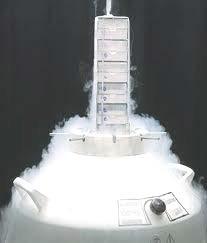Liquid Nitrogen Storage of Cryovials Safety
Cryopreservation, the use of ultra-low temperatures to preserve cell lines and other critical biological materials, has become common practice in modern research. The associated physical hazards of liquid nitrogen, however, carry the risk of serious injury, infection, and specimen contamination in the event of an incident involving cryopreserved materials.
When vials are stored within the liquid-phase of liquid nitrogen, liquid nitrogen can leak into the vials during immersion and rapidly expand when removed from storage and warmed to room temperature. The rapid evaporation of liquid nitrogen in a sealed container can create pressures greater than 10,000 psi if brought to room temperature. Consequently, the vial will shatter when removed from liquid nitrogen storage, creating a hazard from both flying debris and exposure to the contents.
Liquid nitrogen is a simple asphyxiant. If released, liquid nitrogen can displace oxygen when sufficient ventilation is not available. Liquid nitrogen (liquid or vapor) exposure can cause extreme burns on contact with skin or eyes. Precautions should be taken to ensure proper personal protective equipment (PPE) and other measures are used when transferring liquid nitrogen or samples stored in liquid nitrogen.
Use the following precautions for handling cryovials in liquid nitrogen:
- Wear cryogenic gloves, lab coat, impact resistant full face shield that also covers the neck, and closed-toe shoes.
- Do not overfill cryovials beyond the designated fill line. This will increase the risk of cracking and possible release of contents.
- If at all possible, store cryovials in the vapor phase of liquid nitrogen freezers. Most manufacturers of cryovials do not recommend liquid-phase storage.
- When liquid-phase storage is required or necessary, specialized cryoflex tubing or other safety enclosures that can be heat sealed to prevent the entry of liquid nitrogen into cryovials should be used. However, if these items are used inappropriately, the risk of violent rupture is still possible.
- For cryovials immersed in liquid-phase storage, it is recommended that tubes are placed in a sealed, unbreakable, plastic container immediately after removal from storage and prior to thawing. Tubes can also be moved from the liquid-phase to the vapor-phase for at least 24-48 hours prior to removing from the storage container.


